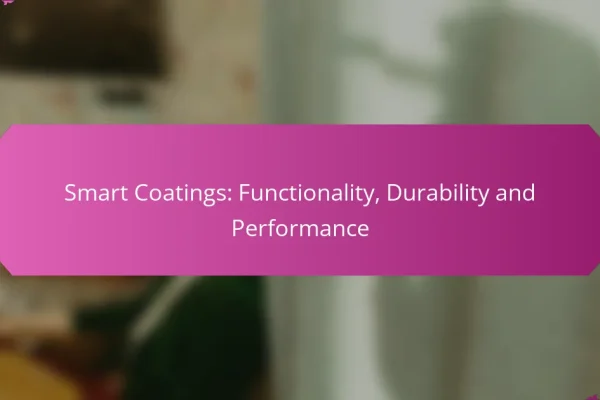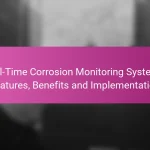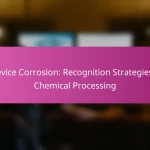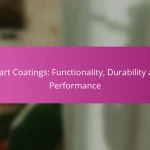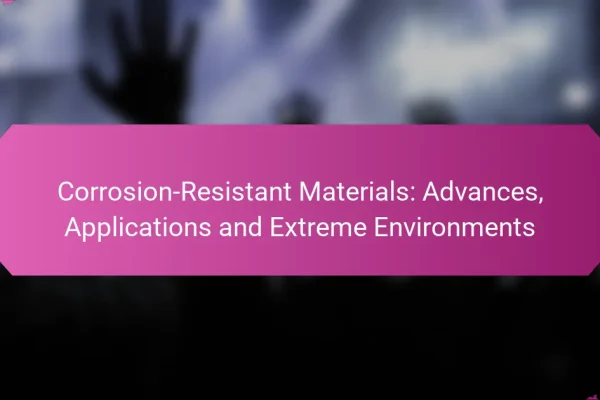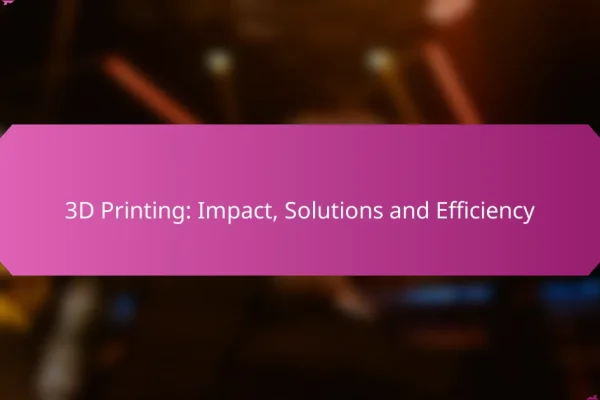What are the latest innovations in corrosion prevention solutions?
The latest innovations in corrosion prevention solutions focus on enhancing durability and efficiency while minimizing environmental impact. These advancements include advanced coatings, corrosion inhibitors, smart monitoring systems, nanotechnology applications, and biodegradable solutions.
Advanced coatings technology
Advanced coatings technology involves the development of protective layers that prevent corrosion on various surfaces. These coatings can be polymer-based, metallic, or hybrid, offering enhanced resistance to moisture, chemicals, and abrasion.
For example, epoxy and polyurethane coatings are widely used in industrial applications due to their strong adhesion and durability. When selecting a coating, consider factors like the environment, substrate material, and expected lifespan to ensure optimal performance.
Corrosion inhibitors
Corrosion inhibitors are substances that, when added to a material or environment, reduce the rate of corrosion. They can be categorized into anodic, cathodic, and vapor-phase inhibitors, each working through different mechanisms to protect metal surfaces.
For instance, anodic inhibitors form a protective film on the metal surface, while cathodic inhibitors reduce the electrochemical reactions that lead to corrosion. Choosing the right inhibitor depends on the specific application and the type of corrosion expected.
Smart monitoring systems
Smart monitoring systems utilize sensors and data analytics to track the condition of structures and detect early signs of corrosion. These systems can provide real-time data, allowing for timely maintenance and reducing the risk of failure.
For effective implementation, consider integrating these systems with existing infrastructure and ensuring compatibility with various sensors. Regular calibration and maintenance of the monitoring equipment are crucial for accurate readings and reliable performance.
Nanotechnology applications
Nanotechnology applications in corrosion prevention involve the use of nanomaterials to enhance protective coatings and inhibitors. These materials can improve barrier properties and increase the effectiveness of corrosion resistance at a molecular level.
Examples include nanoparticles that can be incorporated into coatings to provide self-healing properties or enhanced adhesion. When exploring nanotechnology options, assess the cost-benefit ratio and potential regulatory implications of using these advanced materials.
Biodegradable solutions
Biodegradable solutions for corrosion prevention are designed to minimize environmental impact while effectively protecting metal surfaces. These solutions often use natural materials that break down over time without leaving harmful residues.
Common examples include plant-based oils and polymers that can provide temporary protection during storage or transportation. When choosing biodegradable options, consider their effectiveness compared to traditional methods and the specific conditions they will be exposed to.
How do advanced coatings improve corrosion resistance?
Advanced coatings enhance corrosion resistance by creating a protective barrier that prevents moisture and corrosive agents from reaching the substrate. These coatings can be tailored to specific environments, improving durability and extending the lifespan of materials.
Polymer-based coatings
Polymer-based coatings, such as epoxy and polyurethane, are widely used for their excellent adhesion and flexibility. They form a tough, impermeable layer that effectively shields surfaces from corrosive elements like saltwater and chemicals.
These coatings are particularly beneficial in industries like marine and automotive, where exposure to harsh conditions is common. When selecting polymer-based coatings, consider factors like temperature resistance and application method to ensure optimal performance.
Metallic coatings
Metallic coatings, including galvanization and thermal spraying, provide robust protection against corrosion by applying a layer of metal over the substrate. Zinc is a common choice for galvanization, as it offers sacrificial protection, meaning it corrodes before the underlying metal does.
These coatings are often used in construction and infrastructure projects due to their longevity and resistance to wear. However, they can be more expensive than polymer options, so it’s essential to weigh the cost against the expected lifespan and maintenance needs.
Hybrid coatings
Hybrid coatings combine the benefits of both polymer and metallic coatings, offering enhanced protection and versatility. These coatings can provide the flexibility of polymers while incorporating the durability of metals, making them suitable for a wide range of applications.
For example, a hybrid coating might use a metallic layer for corrosion resistance and a polymer topcoat for UV protection. When considering hybrid options, evaluate the specific environmental conditions and performance requirements to select the best formulation for your needs.
What are the benefits of corrosion inhibitors?
Corrosion inhibitors offer significant advantages by protecting materials from deterioration caused by environmental factors. These benefits include extending the lifespan of materials, enhancing cost-effectiveness, and promoting environmental safety.
Extended lifespan of materials
Corrosion inhibitors effectively slow down the oxidation process that leads to material degradation. By forming a protective layer on surfaces, they can significantly increase the lifespan of metals and alloys, often extending it by several years. For example, using inhibitors in pipelines can prevent costly repairs and replacements.
Regular application of corrosion inhibitors can help maintain the integrity of structures such as bridges and buildings, which are exposed to harsh weather conditions. This proactive approach reduces the frequency of maintenance and ensures long-term durability.
Cost-effectiveness
Investing in corrosion inhibitors can lead to substantial cost savings over time. By preventing corrosion, businesses can avoid the high costs associated with repairs, replacements, and downtime. For instance, industries that rely on heavy machinery can save tens of thousands of dollars by using effective corrosion prevention strategies.
Additionally, the initial investment in corrosion inhibitors is often outweighed by the reduction in maintenance expenses and increased operational efficiency. Organizations should consider the total cost of ownership when evaluating corrosion prevention solutions.
Environmental safety
Many modern corrosion inhibitors are designed to be environmentally friendly, reducing the risk of harmful chemical exposure. This focus on safety aligns with global regulations aimed at minimizing environmental impact. For example, water-based inhibitors are often preferred in industries to ensure compliance with environmental standards.
Using eco-friendly corrosion inhibitors not only protects materials but also contributes to sustainable practices. Companies can enhance their reputation and meet consumer demand for greener solutions by adopting these safer alternatives.
How do smart monitoring systems enhance corrosion management?
Smart monitoring systems significantly improve corrosion management by providing real-time insights and predictive analytics. These technologies help organizations detect corrosion early, allowing for timely interventions that can extend asset life and reduce maintenance costs.
Real-time data collection
Real-time data collection is essential for effective corrosion management. Smart sensors can continuously monitor environmental conditions, such as humidity and temperature, which are critical factors in corrosion processes. This data enables quick decision-making and immediate responses to potential corrosion threats.
For example, sensors placed on pipelines can alert maintenance teams to changes in conditions that may lead to corrosion, allowing for proactive measures before significant damage occurs.
Predictive maintenance
Predictive maintenance leverages data analytics to forecast when corrosion-related failures might occur. By analyzing historical data and current conditions, organizations can schedule maintenance activities just before issues arise, rather than relying on reactive measures.
This approach can lead to substantial cost savings, as it minimizes unplanned downtime and extends the lifespan of equipment. Companies often find that predictive maintenance reduces maintenance costs by a significant percentage compared to traditional methods.
Remote monitoring capabilities
Remote monitoring capabilities allow corrosion management teams to oversee assets from anywhere, enhancing operational efficiency. With internet-connected devices, personnel can access real-time data and alerts without needing to be on-site, which is particularly beneficial for assets in hard-to-reach locations.
For instance, offshore oil rigs can utilize remote monitoring to track corrosion levels, ensuring that maintenance crews are deployed only when necessary, thus optimizing resource allocation and safety.
What role does nanotechnology play in corrosion prevention?
Nanotechnology significantly enhances corrosion prevention by improving the properties of protective coatings and materials. By manipulating materials at the nanoscale, these innovations create barriers that are more effective at resisting environmental factors that cause corrosion.
Enhanced barrier properties
Nanotechnology improves barrier properties by creating coatings that are thinner yet more effective. These coatings can fill microscopic pores and defects, providing a uniform layer that prevents moisture and corrosive agents from reaching the substrate. For example, nanocomposite coatings can reduce permeability by up to 90% compared to traditional coatings.
When selecting coatings, consider the specific environmental conditions they will face, such as humidity and temperature fluctuations. This ensures that the enhanced barrier properties are maximized for the intended application.
Self-healing materials
Self-healing materials incorporate nanotechnology to automatically repair damage, extending the lifespan of protective coatings. These materials contain microcapsules filled with healing agents that release when cracks or scratches occur, effectively sealing the damage. This technology can significantly reduce maintenance costs over time.
When implementing self-healing materials, it’s essential to assess the frequency and type of wear expected. This will help determine the appropriate healing mechanisms and materials needed for effective corrosion prevention.
Reduced weight and thickness
Nano-engineered coatings allow for thinner applications without sacrificing performance, which is particularly beneficial in industries where weight is a critical factor, such as aerospace and automotive. Thinner coatings can lead to lower overall material costs and improved fuel efficiency in vehicles.
Consider the trade-off between thickness and durability when selecting coatings. While thinner options may reduce weight, they must still provide adequate protection against corrosion in the specific operating environment.
What are the emerging trends in corrosion prevention solutions?
Emerging trends in corrosion prevention solutions focus on advanced technologies and innovative materials that enhance protection and longevity. Key developments include the integration of artificial intelligence, machine learning, and smart coatings that adapt to environmental conditions.
Integration of AI and machine learning
The integration of AI and machine learning in corrosion prevention allows for predictive maintenance and real-time monitoring of assets. These technologies analyze vast amounts of data to identify patterns and predict corrosion risks, enabling proactive measures to be taken before significant damage occurs.
For example, AI algorithms can assess environmental factors such as humidity, temperature, and exposure to corrosive agents to provide tailored recommendations for protective measures. This approach can lead to cost savings by optimizing maintenance schedules and reducing unexpected failures.
When implementing AI-driven solutions, it is essential to ensure data quality and relevance. Regularly updating the data sets and refining algorithms can enhance accuracy and effectiveness in predicting corrosion-related issues.
